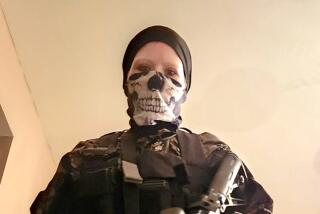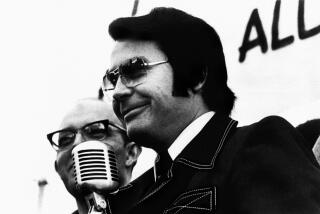Cult’s Path to Violence Is Well Traveled
- Share via
As federal agents laid siege for the second day to a religious cult’s stronghold near Waco, Tex., experts said Monday the group’s fateful drift from its passivist roots to armed resistance could almost be foretold.
All the signs were there--a charismatic leader, a claim to divine authority, unquestioning followers and a foreboding sense that it was “us against them.”
Such was the volatile combination, psychiatrists and others said Monday, that led to mass suicide at Jonestown, ritualistic slayings in Ohio by members of a tiny religious commune and conspiracies in Oregon by followers of the late guru Bhagwan Shree Rajneesh to poison a town’s food supply.
Moreover, as the year 2000 approaches and interest in the so-called “end times” grows more intense, there could be equally deadly encounters in the future.
“It is rare that (cults) turn to wholesale violence on a scale like we’ve seen (in Texas), but it’s not unprecedented,” said Stephen D. O’Leary, a USC assistant professor of communication arts and science whose book, “Arguing the Apocalypse,” is to be published in November by Oxford University Press. “There are enough groups like this out there that I think we can predict there will be more of these in the coming decade.”
The Sunday gun battle--which left six dead, including four agents, and 15 injured--”is not a shock to me at all,” said Margaret Thaler Singer, a San Francisco clinical psychologist known for her study of the 1978 mass suicide at Jonestown, Guyana, of more than 900 members of Jim Jones’ Peoples Temple.
Many facts remain unclear and comparisons with other cults are not always possible. Louis J. West, an expert on cults and a professor of psychiatry at UCLA, said that, based on his observations, it is unlikely that Branch Davidian leader David Koresh will lead his followers, who remain holed up in their fortress, into a Jonestown-style mass murder or suicide.
“The odds are not very great that he would pull a ‘Jim Jones’ simply because (cult leaders) usually don’t,” West said.
Nonetheless, based on initial reports, the Branch Davidians shared a number of the same characteristics that contributed to violence involving other cults. “He’s certainly got them transformed from an extremely peaceful, Christian theory to shooting at strangers and killing them--something that Jesus of Nazareth might not have done or taught,” said West.
Like Jones’ Peoples Temple and the Bhagwan Shree Rajneesh, Koresh’s Branch Davidian claimed to aspire to a higher calling--love, true worship, a sense of fellowship and community.
In fact, the forerunners of Branch Davidian severed all ties with the Seventh-day Adventists because the church was not passive enough: It allowed conscientious objectors to serve in noncombat capacities in the armed forces.
Today, there is no connection between the Seventh-day Adventists and Branch Davidian.
Over a period of time, however, each of the cults began to turn inward--a movement abetted by an absolute belief in their special place in the scheme of things and leaders who gathered to themselves increasing power and influence over their adherents.
One man who considered joining Branch Davidian and knew Koresh well, said in an interview Monday: “You felt you were part of the struggle. It was like being part of an exclusive club. You felt special and you felt everyone else was lost.” Ultimately, the man, who asked not to be identified, didn’t join the group.
There are three telltale signs of a cult, according to West. He said cults are more likely to have a single authoritarian leader, as well as some kind of elaborate doctrine or teaching to which all must adhere. Finally, there are rigid boundaries that define who is “in” and who isn’t. “There’s a ‘we versus they’ division of the world,” West said.
More to Read
Sign up for Essential California
The most important California stories and recommendations in your inbox every morning.
You may occasionally receive promotional content from the Los Angeles Times.












